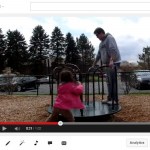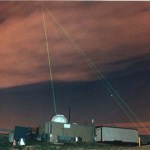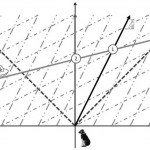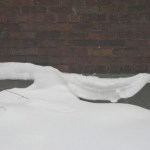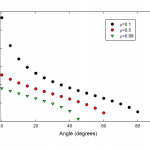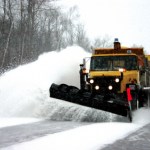Estimation
In yesterday's post about the lack of money in academia, I mentioned in passing that lack of funding is part of the reason for the slow pace of progress on improving faculty diversity. That is, we could make more rapid progress if we suddenly found shitloads of money and could go on a massive hiring binge, but in the absence of flipping great wodges of cash, change comes more slowly.
This, naturally, sparked a sort of morbid curiosity about whether the scale of this problem would be quantifiable, and of course, there's the AIP Statistical Research Center offering numbers on all sorts of…
There's a new Science Express paper on interfering clocks today, which is written up in Physics World, with comments from yours truly. The quote is from a much longer message I sent-- with no expectation that it would end up as anything other than a pull quote, I might add, but I thought the background would be helpful. Since I ended up doing a back-of-the-envelope estimate for that, though, I thought I would reproduce some of the reasoning here.
The basic proposal idea here is to do an atom interferometer inside a Ramsey interferometer for making an atomic clock. That is, before sending the…
There was some Twitter chatter the other night about a new arxiv paper called The Gender Breakdown of the Applicant Pool for Tenure-Track Faculty Positions at a Sample of North American Research Astronomy Programs:
The demographics of the field of Astronomy, and the gender balance in particular, is an important active area of investigation. A piece of information missing from the discussion is the gender breakdown of the applicant pool for faculty positions. For a sample of 35 tenure-track faculty positions at 25 research universities advertised over the last few years in astronomy and…
We're going to depart from the chronological ordering again, because it's the weekend and I have to do a bunch of stuff with the kids. Which means I'm in search of a story I can outsource...
In this case, I'm outsourcing to myself-- this is a genuine out-take from Eureka: Discovering Your Inner Scientist, specifically Chapter 2, which tells two stories from the career of Luis Alvarez, who I've talked about before in the context of his experiment to x-ray one of the pyramids at Giza, and the time I wrote him a letter when I was nine about his theory that an asteroid impact killed the dinosaurs…
I'm teaching relativity in a course with an astronomy prefix, which means I'm obliged to talk about stars and stuff. Yesterday's lecture was about neutron stars, and how their existence was confirmed by the discovery of pulsars (with the story of Jocelyn Bell Burnell included). This requires some discussion of angular momentum to explain how something that big ends up spinning that fast (cribbing a bit from these online notes), so I needed a good demonstration of angular momentum. Which is when I remembered this 2013 post with SteelyKid on the playground, where I estimated the mass of the…
This Alberto Cairo piece on "data journalism" has been kicking around for a while, and it's taken me a while to pin down what bugs me about it. I think my problem with it ultimately has to do with the first two section headers in which he identifies problems with FiveThirtyEight and Vox:
1. Data and explanatory journalism cannot be done on the cheap.
2. Data and explanatory journalism cannot be produced in a rush.
The implication here is that "data and explanatory journalism" is necessarily a weighty and complicated thing, something extremely Serious to be approached only with great care.…
I didn't plan to do a follow-up to yesterday's post about the optics of sending messages with lasers, but then I starting idly thinking about detection, prompted in part by a bunch of conversations with my summer students about single-photon detectors. which led to scribbling on the back of an envelope, which led to Googling, and suddenly, I have a follow-up post.
So: as we said yesterday, if you want to send messages over a distance of ten light years, a relatively efficient way to do this might be to send them via lasers. This results in the light being spread over a pretty big area, though…
In the comments to yesterday's grumpy post about the Fermi paradox, makeinu raises the idea that advanced aliens would be using more targeted communications than we do:
On the point about electromagnetic communications: even we are now using lasers to target communications with space, because it’s simply more efficient and reliable.
It’s also basically impossible to intercept, since you literally have to interrupt the beam to do so.
This is true, to a point, but when you're talking about interstellar distances, it's not quite true that you have to interrupt the beam to detect communications…
I've seen a bunch of people linking approvingly to this piece about the "Fermi paradox," (the question of why we haven't seen any evidence of other advanced civilizations) and I can't quite understand why. The author expends a good deal of snark taking astronomers and physicists to task for constructing elaborate solutions to Fermi paradox on the basis of shoddy and unjustified assumptions. And then proceeds to offer a different solution for the Fermi paradox based on shoddy and unjustified assumptions. Whee!
I mean, there is an element of this that's useful, namely the reminder that "We…
For some reason, the topic of really big rocks came up at dinner the other night, and SteelyKid declared that she wanted to find "A rock as big as the solar system." We pointed out that that was pretty much impossible, more or less by definition, rocks being sub-parts of the solar system.
"OK, how about a rock as big as Jupiter?" That's a much harder question to answer, and required a trip to the Internet. Not during dinner, of course-- it's hard enough to get her to eat when we're all sitting at the table-- but a day or so later, which led to this blog post.
So, there are a couple of…
I don't have anything all that new to say about last night's Cosmos reboot, and I'm leaving for scenic Madison, WI today to attend DAMOP, so I don't have a great deal of time. Kate did mention something over dinner last night, though, that's a good topic for a quick blog post.
Kate's a big listener of audiobooks and podcasts, including The Naked Scientists podcast, and she mentioned something they said in responding to a question about charging phones and the cost of electricity:
I think my favourite one is a microwave oven. So, the clock on a microwave oven uses more electricity over the…
Last week's talks were using sci-fi space travel as a hook to talk about relativity, and my original idea for the talk was to explain how faster-than-light travel ultimately ends up violating causality. Some observers will see effects happening before the events that cause them, and that's just weird. In How to Teach Relativity to Your Dog, the illustration I use is a stationary dog watching a cat moving by at half the speed of light and a space alien zipping past at four times the speed of light. In that scenario, the dog can hand a water balloon to the passing alien to soak the cat, and…
Ages and ages ago, I posted the picture that's the "featured image" above, and asked people to submit physics comments about it. Then I got distracted by a series of shiny things, and never did anything with the handful of responses I got. Because I'm a Terrible Person.
Anyway, it's long overdue, but here are the responses, with some comments from me. The first to send me something was Keith Hester, who emailed:
I find quite intriguing the lengthy unbroken --- and seemingly unsupported --- extension of snow that has slid over the left edge of the roof. The coefficient of friction between…
In the previous post about luge, I mentioned that there was one thing that came up when Rhett and I were talking about this, namely why there are differences in times between racers. The toy physics model I set up last time suggests that the difference between riders is only a matter of aerodynamics-- two riders with the same mass and cross-sectional area ought to achieve the same speed. So why do they all get different times?
Well, if the sleds and other gear were all identical and locked into tracks, then mass and aerodynamics would be the entire story. But they're not-- the rules allow for…
We got over a foot of snow yesterday and today, so schools are closed. Except Union is a residential college, so we never close, which means I have to dig my car out all the same. Which I did, clearing a path to the unplowed street, then took Emmy for her morning walk. During which, of course, the town snow plows came around and filled in the end of our driveway again...
As I was digging out again, I was struck by just how far the snow had gone up the driveway-- I paced off about six meters from the edge of the road to the farthest clumps thrown up the driveway. As a way to distract myself…
--A great NYT article on science museums and cabinets of curiosities:
This antic miscellany is dizzying. But there are lineaments of sustained conflict in the apparent chaos. Over the last two generations, the science museum has become a place where politics, history and sociology often crowd out physics and the hard sciences. There are museums that believe their mission is to inspire political action, and others that seek to inspire nascent scientists; there are even fundamental disagreements on how humanity itself is to be regarded. The experimentation may be a sign of the science museum's…
